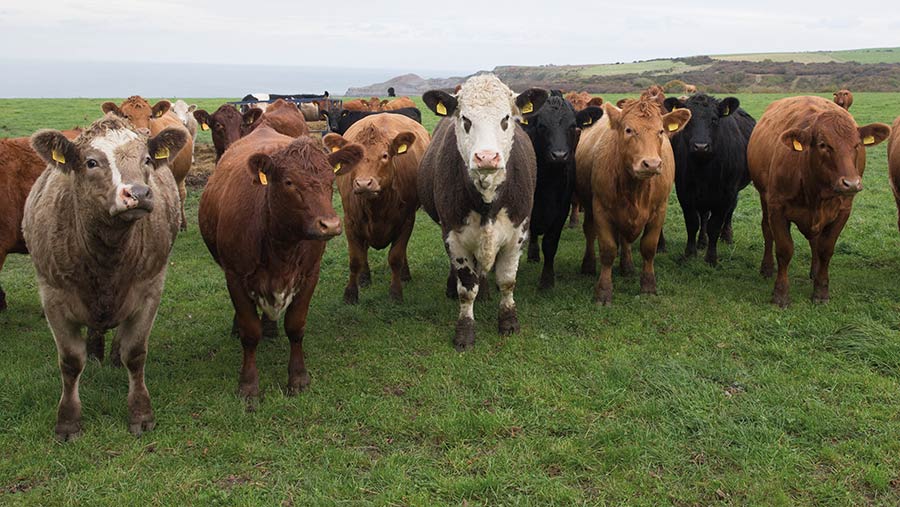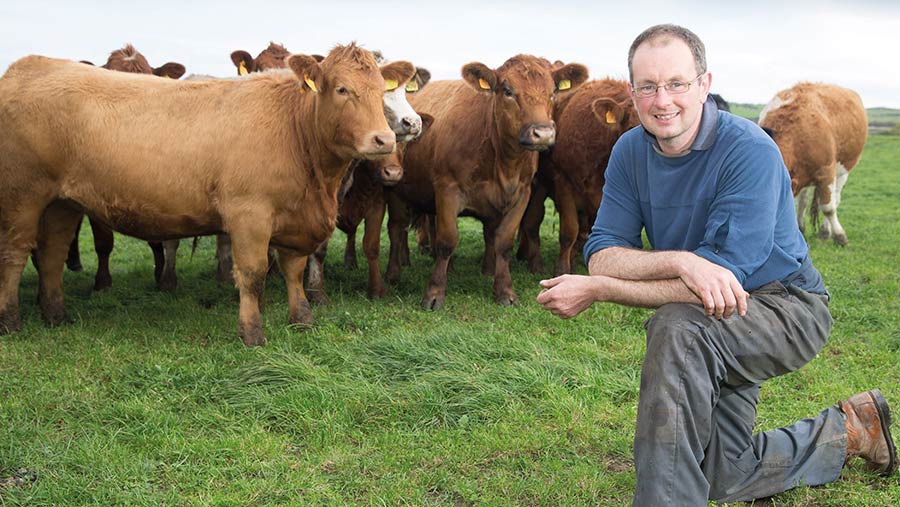How to improve beef rations for better colostrum at calving
 © Tim Scrivener
© Tim Scrivener Good-quality colostrum is essential for calving.
Sarah Pick, senior knowledge exchange manager for AHDB Beef and Lamb, gives advice on how to achieve this.
We also find out how AHDB’s strategic farmer Guy Prudom has managed to increase his weaning percentage by 4%.
See also: 5 KPIs to measure suckler herd performance
Why is good nutrition so important?
Optimum pre-calving nutrition is essential to allow the cow to produce good-quality colostrum and provide her with the nutrients she needs for successful calving.
In a recent study, blood samples were taken from pre-calving cows and their metabolic profile was analysed.
The results showed more than one in three cows were in negative energy balance and two in three had very poor short-term protein status.
The suckler cow must calve unaided, produce good-quality colostrum and milk, and return to cycling within six weeks of calving. She will be unable to do this if she is nutritionally restricted.
Poor energy in the run-up to calving is associated with an increased risk in failure of passive transfer (FPT) of immunity.
Other risk factors for this include:
- Assisted calving
- Assistance with colostrum feeding
- Bull calves, because they are at a higher risk of calving difficulties and assistance
- Being born to a heifer
- Being born a twin
It takes approximately five months to develop a healthy egg to ovulation, which means the process begins during the last trimester of the previous pregnancy.
Therefore, nutrition during the month before calving not only impacts the current pregnancy but the success of the following one as well.
Consider asking your vet to take blood samples from your suckler cows to test the nutritional status of your herd. This will help you to manage rations to avoid calving issues related to nutrition.
Top pre-calving nutrition tips
- Ensure cows are in body condition 2.5-3.0 at least one month prior to calving
- Ensure cows are fed to meet their current energy and protein requirements during the last month of pregnancy
- Use a high-magnesium (Mg) (10-15%) dry-cow mineral to supplement suckler cows in the last month of pregnancy. Mg is important because it helps prevent hypomagnesemia (grass staggers) which is caused by low blood Mg concentrations. It is most common in cows that have calved within the past three months. Mg cannot be stored in the body so it must be supplied in the diet.
Case study: Guy Prudom, Whitby, North Yorkshire

Guy Prudom © Tim Scrivener
Yorkshire suckler beef farmer and AHDB’s strategic farmer, Guy Prudom, has increased his weaning percentage by 4% by improving dry cow nutrition.
Guy and his family run a spring-calving herd of 230 Stabiliser-cross cows on their 405ha (1,000 acre) tenanted farm near Whitby, North Yorkshire.
Farm facts
- 230 Stabiliser- and Simmental/Angus-cross suckler cows
- 405ha (1,000-acre) farm with 60% arable land
- Farm split across three tenanted holdings, Northfields Farm, Davison Farm and High Burrows Farm, which are all part of the Mulgrave Estate
- Finished animals supply Dovecote Park and Dunbia
He first noticed a problem during the 2017 calving season.
“We had quite a few calves that were unthrifty at birth and took a while to suckle. We then went on to lose a few after turnout with pneumonia and coccidiosis.
“At the time, we just put it down to the bad spring we had.”
However, the following year, as part of his involvement as an AHDB strategic farmer, he was given the opportunity to take part in an AHDB-funded study investigating the impact of dry cow nutrition on colostrum quality and quantity.
As part of the study, blood samples were taken from 10 cows one month before calving and sent off to the lab for analysis.
“The results showed our cows were low in protein and energy and therefore we needed to make changes to our dry cow ration.”
Ration changes
The energy was simple to sort – to increase the energy density of the dry cow diet, he changed the silage-to-straw balance.
Addressing the protein was a little trickier, he admits.
“We now start feeding soya one month before calving. Four weeks before calving begins, we supplement 250g a head a day and increase it by 250g a head a day each week.
“So, by the time the cows and heifers start calving they are being supplemented with 1kg of soya a head a day.”
Improvements
Since making the changes, calf mortality rates have dropped, and Mr Prudom weaned 4% more calves in 2021 than in 2018.
The dry cow ration has a big impact on conception rates and the data he collects supports this, with scanning rates lifting from 86% in 2018 to 91% in 2020, in a 10-week period.
Colostrum management
Cows calve in groups and are paired up using marker in case there are any problems. Heifers are individually penned to help ensure they suckle and mother up.
Mr Prudom also ensures that any calves that don’t suckle within the first two hours of life are tube-fed colostrum.
“Anything I calve, I tube straight away. My data suggests that these are the ones that don’t suckle straight away.
“I always think it’s a lot easier making sure they get their colostrum now rather than trying to catch them in a field four weeks later to treat them for pneumonia or scours,” he explains.
If the cow, or, more commonly, the heifer, looks like she has not got much milk, he says he always checks the quality of the colostrum using a Brix refractometer.
A Brix refractometer provides a quick indication of the amount of immunoglobulin in the colostrum.
Ideally, colostrum should have a reading above 22%, which means it contains 50 mg/ml of immunoglobulins.
Good management to tighten the calving period
Tightening up his calving block to nine weeks has helped when it comes to feeding dry cows.
“Reducing the calving period has really helped us manage our dry cows better, meaning they all get the extra protein when they really need it.
“If we had a prolonged calving period, feeding them correctly would be extremely challenging.”
Mr Prudom has also implemented rotational grazing, which has increased his grassland utilisation. “I am now grazing 20% more cows on the same amount of land I used to.”
